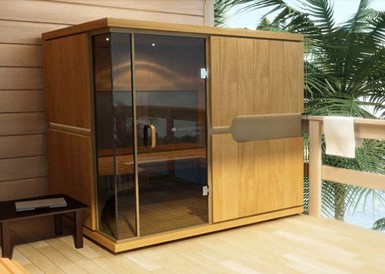

What is an infrared (IR) sauna? Infrared saunas provide heat via infrared light waves (radiation), that directly heat your body creating controlled hyperthermia, like a fever. Raising body temperature will help increase sweat production, which is one of the body’s main ways to detoxify. Your body also detoxifies through stool, urine, and breathing. A traditional sauna does not use IR, and heats your body by heating the surrounding air. An IR sauna, compared to a traditional sauna allows approximately 7’xs more toxins to be eliminated due the ability to penetrate the skin up to 1.5 inches deep [1]. There are 3 types of IR spectra, each with their own separate benefits. Far IR is the most common, as the benefits are mainly via improving detoxification. Middle IR is known for increasing circulation, muscle relaxation, and weight loss. Near IR is used for wound healing and skin benefits, including increased collagen production and cell turn over. All spectra provide relaxation and stress management benefits.
General detoxification is the main use for IR saunas globally. Since your skin is the largest organ you have, a significant amount of detoxification occurs through it, which means IR sauna use can also improve skin purification and appearance. A few medical conditions in which IR sauna has shown benefit include pain conditions, chronic fatigue, depression, type II diabetes, cardiovascular disease, and some cancers. To geek out for a second, let’s talk about how IR affects us at the most basic level, at the level our cells. IR changes cell membrane potentials and mitochondrial metabolism [1]. The mitochondria are the “powerhouses” of our cells, where cellular respiration and energy production occur. Knowing this, it is easy to see how affecting the cells will directly how we feel, and is one of the reason it has anti-aging benefits. IR can also affect fast growing cells like certain cancers in a positive way by decreasing their growth [1].
Now, let’s talk about IR sauna studies and some medical conditions specifically! A study on patients with type II diabetes showed improved physical health, social function, and fatigue, and decreased levels of stress after using a sauna for 3 months in a row, 3 times per week for 20 minutes per session [2]. Another study in rheumatoid arthritis and ankylosing spondilitis (autoimmune conditions that can cause chronic joint pain) patients showed that sauna use had a reduction in pain and stiffness, and an improvement in fatigue [3]. And perhaps one of the most studied areas in IR sauna use is in the field of cardiovascular medicine. Besides improved cardiac (heart) and vascular (blood vessel) function and an overall decrease in oxidative stress [1], it has also been shown to specifically improve myocardial perfusion (blood flow to the heart) in patients with ischemic coronary artery disease (blocked blood vessels in the heart)[4]. There are many more examples of IR sauna benefits for other medical conditions as well.
IR sauna also improves stress management by promoting relaxation and helping to balance cortisol, your body’s main stress hormone. Other uses are increasing athletic performance by improving neuromuscular recovery, relief of muscle aches and joint pains. Also, using an IR sauna prior to massage or chiropractic manipulation can help loosen up muscles to get better results. It can also be utilized after a massage to further loosen up muscles and to help move out toxins that were mobilized during the massage. IR sauna use can also help with weight loss. An article for the AMA concluded that a 30 min IR sauna session could burn up to 600 calories via the effect of sweating.
In summary, there are numerous benefits to IR sauna use! I personally really enjoy a good sauna session. I always feel so good and relaxed afterwards, and typically get complements on my glowing skin. If you want to try an IR sauna session, ask your healthcare provider if he/she feels it safe for you, and give it a try!
General Recommendations on Sauna Use:
– Start with a 5-minute session at around 100-130 degrees F to see how your body responds. At repeat sessions, slowly increase the amount of time you are in the sauna until you reach 30 minutes. Once you are able to stay in for 30 minutes comfortably, you may work your way up to 60 minutes. DO NOT attempt to sauna for more than 30 minutes your first time, and DO NOT tough it out! If you get any symptoms at all, step out of the sauna and cool down. Saunas can get as hot as 150 degrees F.
– Make sure you are well hydrated! Bring plenty of water with you. If you know you are dehydrated, do not attempt to sauna, as you will lose more water and electrolytes when you sweat. Use caution if you are on blood pressure medications or diuretics (“water pills”). Also it is best to avoid caffeine before your session, as it has diuretic effects also.
– Avoid eating one hour before a session to avoid digestion issues.
– Also, if you already have a fever, feel tired or drained or weak, it is best to avoid the sauna that day.
– If you have chronic fatigue and/or muscle weakness, you should avoid the sauna until you can go for a one-mile walk without getting tired, as the sauna will be depleting to you.
– Ideally choose a day when you are not exercising, as doing a sauna session will require a good amount of energy.
– If you are pregnant, breastfeeding, or a male trying to conceive, it is best to avoid the sauna.
– If you have any type of neuropathy, or nerve damage, use caution, as you may not be able to feel yourself getting too hot.
– If you have a skin condition such as eczema or psoriasis, note that sauna sessions may initially aggravate symptoms, however are likely to improve long term.
– If you have constipation, avoid sauna use until you have regular daily bowel movements, as stool is also one of the main ways your body detoxifies.
– If you have cancer or any other serious medical condition, or an implant of any kind, please consult your physician before sauna use.
References:
1. Far Infrared Radiation: It’s biological effects and medical applications. Photonics Lasers Med 2012 Nov 1; 4:255-266.
2. Beever R. The effects of repeated thermal therapy on quality of life in patients with type II DM. J Altern Complement Med. 2016; 16 (6): 677-81.
3. Oosterveld FG, Rasker JJ, Floors M, Landkroon R, van Rennes B, Zwijnenberg J, van de Laar MA, Koel GJ. Infrared sauna in patients with rheumatoid arthritis and ankylosing spondylitis. A pilot study showing good tolerance, short-term improvement of pain and stiffness, and a trend towards long-term beneficial effects. Clin Rheumatol. 2009; 28(1): 29–34.
4. Sobajima M, et al. Repeated sauna therapy improves myocardial perfusion in patients with chronically occluded coronary artery-related ischemia. Int J Cardiol 2013 Jul 15; 167(1) 237-43.
Share:
Social Media
Most Popular Posts
Subscribe To Our Newsletter
Related Posts

Understanding the Essential Labs for Women on Hormone Replacement Therapy (HRT)
So what are the minimum labs we’re looking at when we do hormone replacement therapy? We obviously want to look at an estrogen level, so

How to figure out the right amount of HRT in women
What about checking lab values when you’re on hormone replacement therapy? I do find it to be helpful, but we also want to consider symptoms.

Did you know there’s a difference between food allergies, sensitivities, and intolerances?
Did you know that there’s a difference between food allergies, food sensitivities and food intolerances? Food allergies, the reactions tend to happen pretty immediately and

Food Intolerances: Symptoms, Causes, and How They Differ From Food Allergies and Sensitivities
Eating a wide variety of whole foods is a key way to ensure a nutrient-rich diet full of vitamins and minerals. But what happens when
